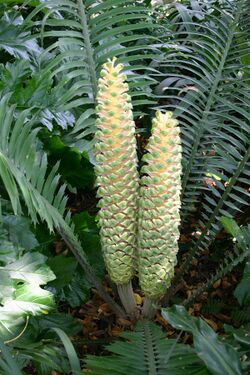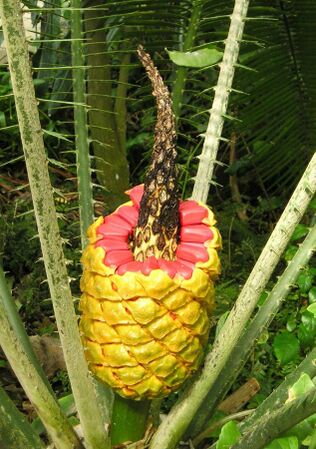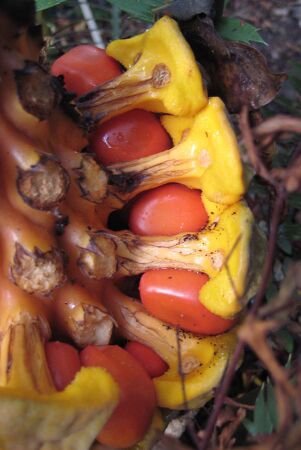Biology:Encephalartos villosus
| Encephalartos villosus | |
|---|---|

| |
| Male cones | |
| Scientific classification | |
| Kingdom: | Plantae |
| Clade: | Tracheophytes |
| Clade: | Gymnospermae |
| Division: | Cycadophyta |
| Class: | Cycadopsida |
| Order: | Cycadales |
| Family: | Zamiaceae |
| Genus: | Encephalartos |
| Species: | E. villosus
|
| Binomial name | |
| Encephalartos villosus Lem.
| |

| |
native range
| |
| Synonyms | |
| |
Encephalartos villosus is a South African cycad occurring from the East London vicinity, where it is found near the coast, to the northern border of Eswatini (Swaziland) where it may grow as far as 100 km inland. The species is common throughout its range and is the most frequently cultivated in Southern Africa, largely because of its affordable price. As a result of its large geographical distribution, it is notably variable in leaf and cone shape.
Description
A largely underground trunk results in very little of the plant being visible, so that it is described as a dwarf species, although it can sometimes grow above ground, reaching heights of up to 0.4 m and a diameter of 250 mm, and occasionally producing suckers. The crown normally consists of tightly-packed bracts covered in dense grey woolly hair (villosus = hairy). As with all cycads this species is dioecious. Male plants may carry up to 15 cones, whereas only one or two occur on the females. The seeds, embedded in bright-red flesh are eaten and distributed by the purple-crested lourie (Tauraco porphyreolophus) and by the trumpeter hornbill (Bycanistes bucinator).[3] Its young leaves are densely covered in white hairs, while mature leaves are dark green and glossy, with a lighter shade on the underside. These leaves are 1.5 to 3 m long, with median leaflets measuring 150 to 250 mm in length and 15 to 20 mm in width. Female plants of this species produce 1 to 4 cones, which are deep yellow and measure 300-500 x 200-250 mm, containing dark red seeds. The male cones, which can be lemon-yellow and measure 600-700 x 120-150 mm, can bear up to 5 cones and emit an unpleasant odor when mature.[4]
Distribution
The preferred habitat of this species is frost-free coastal bush. It hybridises readily with Encephalartos altensteinii in the Eastern Cape and with Encephalartos lebomboensis in the Pongola area.
Gallery
References
- ↑ Donaldson, J.S. (2010). "Encephalartos villosus". IUCN Red List of Threatened Species 2010: e.T41947A10608666. doi:10.2305/IUCN.UK.2010-3.RLTS.T41947A10608666.en. https://www.iucnredlist.org/species/41947/10608666. Retrieved 12 November 2021.
- ↑ "Appendices | CITES". https://cites.org/eng/app/appendices.php.
- ↑ Douglas Goode - Cycads of Africa - Struik Wincester 1989
- ↑ "Encephalartos villosus". https://pza.sanbi.org/encephalartos-villosus.
External links
Wikidata ☰ Q144446 entry
 |




